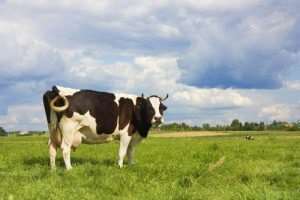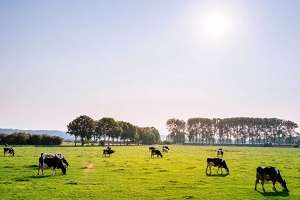By Robert Parkhurst
Americans’ fondness for milk, yogurt, cheese and juicy burgers requires a huge livestock industry, with nearly 90 million head of cattle in the U.S. in any one year. All those cows mean significant methane emissions.
With estimates from the United Nations that methane accounts for 44 percent of all greenhouse gas emissions from livestock production, and new determination – including legislation in California – to reduce methane emissions from farms, we need to figure out how to quantify and then reduce those emissions.
Yet measuring methane emissions has been an elusive science. Methane is a colorless, odorless gas that packs a powerful punch: Methane has 84 times the global warming potential of carbon dioxide in the short term.

Two sources of methane on farms
Livestock emit methane in two ways. One is via enteric fermentation, the natural digestive system of cows and other ruminants that causes substantial burping. The second is via manure, especially when that manure is stored in a liquid system.
Currently, the EPA has only estimates of how much each pathway produces, based on per cow averages of biological factors adjusted for different regions. However, farmers have neither proven tools to determine their methane emissions nor information on how best to minimize those emissions on their farms.
Globally enteric fermentation is the biggest source of methane from livestock farming. On California dairy farms, however, manure may be a larger source of methane emissions because of a practice of storing manure in liquid systems.
Better data needed for better management
If farmers are to mitigate methane emissions, they need to know where and under what conditions the emissions occur. And they need management options that have been proven to make a difference.
Environmental Defense Fund, thanks to a generous grant, is helping to quantify methane emissions from different management approaches. This work builds on EDF’s earlier efforts to develop good estimates of methane released through the energy sector.
EDF pioneered tools to measure methane emissions from oil and gas exploration – the largest source of U.S. methane emissions – through 16 independent scientific studies. The precise measurements that resulted have facilitated efforts to reduce methane emissions from oil and gas operations.

Two tests underway
Now, EDF is using its knowledge to test ways to measure and inventory emissions from livestock operations. Earlier this year, we conducted initial investigations at two dairies in California.
In this study, EDF relied on three methodologies to measure methane: one taken by aircraft above the dairies and two using different methods taken on the ground. This comparison is intended to help clarify differences in reported emissions and establish a clearer baseline for emission reductions.
While the data are not all in, the clock is ticking. California legislators this fall passed a law requiring the state’s dairy farmers to reduce methane emissions from manure management operations by a target of up to 40 percent of 2013 levels by 2030. The law tells the state Air Resources Board to issue rules on manure emissions and include enteric fermentation emissions once mitigation technologies become available.
In California, one of the efforts is focused on capturing manure methane in biogas digesters and converting the gas into energy. As a part of the revenue from the state’s cap-and-trade program, the state set aside funds to help farmers build them. But digesters are costly, so farmers would need additional investment capital to install them, and they’d need to forge contracts with utilities to buy the energy produced.
Click here to see more...